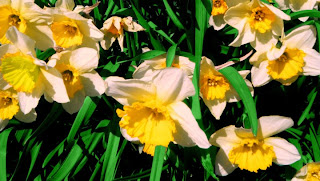 |
| I zoomed in on three of these flowers to provide a balance (one on each side and one in the middle). |
One of the best things about flower photographs is that they are outside (unless they are in a vase or pot inside, of course). When you have a very sunny day, that natural light will benefit your pictures better than anything else. And remember: flowers aren't the only pretty plant! Weeds, leaves, and so on can make wonderful pictures as well.
 |
| The vibrant greens and yellows really make this picture pop. Notice the darkness between the green blades. Playing around with the brightness and darkness of a picture can make a big difference. |
 |
| Again, darkening the shadows around the flower make it stick out drastically. |
 |
| These are rose pedals that I had in a bowl and sprinkled water on. I wasn't necessarily going for the fake dew look, but I wanted to water droplets to be there. |
 |
| Would you have ever known that behind this flower there were other flowers and grass? I didn't remove the flower and put it on a black background, I just played with the darkness setting! So what did you think? I briefly mentioned the elements of art and that they are key in photographs as well. For further information about the elements of art, check out Art Elements Also, I mentioned indirectly a few principles of art. These can also be applied to photographs. For more information, check out Art Principles Most of my photo editing is done in Picasa which is made by Google. It is simple and FREE. Download it here: Picasa |







No comments:
Post a Comment